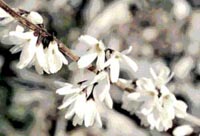Resource Library
Plant of the Week: White Forsythia
The University of Arkansas System Division of Agriculture does not promote, support or recommend plants featured in "Plant of the Week." Please consult your local Extension office for plants suitable for your region.
Plant of the Week
White Forsythia
Latin: Abeliophyllum distichum

When a businessman goes to the trouble of hiding his true identity by using an alias, warning bells usually sound and we begin looking for some nefarious motive.
The businessman in question - one Amos Pettingill - was ousted almost 40 years ago but continues to use the pen name as a kind of insider joke amongst gardeners. Mr. Pettingill’s firm, White Flower Farm of Litchfield, Conn., introduced the white forsythia to American gardeners in 1955.
The white forsythia is a deciduous shrub that produces small white flowers in terminal racemes in very early spring. Plants grow 5 feet tall and wide and produce opposite, abelia-like leaves. The overall plant form is scraggly and open with a more or less unkempt appearance.
The plant is a member of the olive family, as is the true forsythia, and has half-inch wide flowers bearing four pure white petals. The plant is hardy from Zones 4 to 8 but is not widely grown. It was originally discovered in Korea and introduced to England in 1924.
Our Mr. Pettingill assumed his alias innocently enough. When the nursery was founded in 1950 by William Harris (1900-1981) and his wife Jane Grant (1892-1972), they needed a manager because both owners were working in the New York publishing world. They promoted the business under the name of their manager to make it more personal, but they soon realized that hired managers can have short tenure.
To solve this turnover dilemma and still maintain a personal touch, Harris - an editor for Fortune magazine and investment banker on Wall Street - began writing the fledgling company’s catalogs under the name of "Amos Pettingill."
The name White Flower Farm was selected because Grant and Harris had a white garden at their Connecticut farmhouse and initially decided to sell only white flowered plants. While an interesting concept, such a narrow product offering could hardly expect to attract a wide audience amongst gardeners.
Jane Grant, a Missouri farm girl who made her mark on New York society during the roaring 20s, was one of the early feminists. She and a few friends founded the Lucy Stone League, an organization that encourages women to keep their own name when they marry. Her first marriage was to Harold Ross, and together they founded The New Yorker magazine. After their marriage failed, she traveled extensively throughout Asia and the Middle East as a correspondent for the New York Times. She and Harris married in 1938.
The firm started out with the concept of being an upscale purveyor of new plants to well-heeled gardeners. They continue to maintain this aura of exclusivity by offering a few really exclusive plants such as a variegated Clivia - of which only 45 plants existed - which they offered for sale at $950 each. Harris sold White Flower Farm in 1976 to Eliot Wadsworth II who built it into the nation’s second largest mailorder nursery with over 300 acres of production.
In truth, the white forsythia is not much of a shrub. It’s main claim to fame is that it flowers very early when almost nothing else is out to compete for attention, so it gets noticed. It should be given full sun to partial shade in any average garden soil. Because of its rangy nature, it needs to be cut to the ground every three or four years and renewed to keep it looking more presentable.
By: Gerald Klingaman, retired
Extension Horticulturist - Ornamentals
Extension News - March 9, 2001
The University of Arkansas System Division of Agriculture does not maintain lists of retail outlets where these plants can be purchased. Please check your local nursery or other retail outlets to ask about the availability of these plants for your growing area.